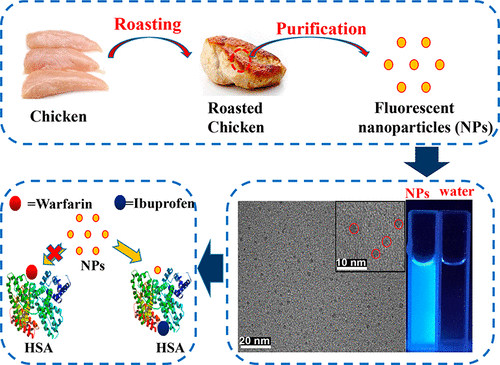当前位置:
X-MOL 学术
›
J. Agric. Food Chem.
›
论文详情
Our official English website, www.x-mol.net, welcomes your
feedback! (Note: you will need to create a separate account there.)
Characterization of Endogenous Nanoparticles from Roasted Chicken Breasts
Journal of Agricultural and Food Chemistry ( IF 5.7 ) Pub Date : 2018-06-22 00:00:00 , DOI: 10.1021/acs.jafc.8b01988 Xunyu Song 1, 2 , Lin Cao 1, 2 , Shuang Cong 1, 2 , Yukun Song 1, 2 , Mingqian Tan 1, 2
Journal of Agricultural and Food Chemistry ( IF 5.7 ) Pub Date : 2018-06-22 00:00:00 , DOI: 10.1021/acs.jafc.8b01988 Xunyu Song 1, 2 , Lin Cao 1, 2 , Shuang Cong 1, 2 , Yukun Song 1, 2 , Mingqian Tan 1, 2
Affiliation

|
Emergence of endogenous nanoparticles in thermally processed food has aroused much attention due to their unique properties and potential biological impact. The aim of this study was to investigate the presence of fluorescence nanoparticles in roasted chicken breasts, elemental composition, physicochemical properties, and their molecular interaction with human serum albumin (HSA). Transmission electron microscopy analysis revealed that the foodborne nanoparticles from roasted chicken were nearly spherical with an average particle size of 1.7 ± 0.4 nm. The elemental analysis of X-ray photoelectron spectroscopy showed the composition of nanoparticles as 47.4% C, 25.8% O, and 26.1% N. The fluorescence of HSA was quenched by the nanoparticles following a static mode, and the molecular interaction of nanoparticles with HSA was spontaneous (ΔG0 < 0), where hydrogen bonding and van der Waals forces played an important role during HSA-nanoparticles complex stabilization through thermodynamic analysis by isothermal titration calorimetry. The principal location of the nanoparticles binding site on HSA was primarily in site I as determined by site-specific marker competition. The conformational of HSA was also changed and α-helical structure decreased in the presence of nanoparticles. Our studies revealed that fluorescent nanoparticles were produced after roasting of chicken breast at 230 °C for 30 min for the first time. The obtained nanoparticles can interact with HSA in a spontaneous manner, thus providing valuable insight into foodborne NPs as well as their effects to human albumin protein.
中文翻译:

烤鸡胸脯内源性纳米颗粒的表征
热处理食品中内源性纳米粒子的出现由于其独特的性能和潜在的生物学影响而引起了人们的极大关注。这项研究的目的是研究烤鸡胸肉中荧光纳米颗粒的存在,元素组成,理化特性以及它们与人血清白蛋白(HSA)的分子相互作用。透射电子显微镜分析显示,来自烤鸡的食源性纳米颗粒接近球形,平均粒径为1.7±0.4 nm。X射线光电子能谱的元素分析表明,纳米粒子的组成为47.4%C,25.8%O和26.1%N。HSA的荧光以静态模式被纳米粒子淬灭,并且纳米粒子与HSA的分子相互作用是自发的(ΔG 0 <0),其中氢键和范德华力在通过等温滴定量热法进行热力学分析的HSA-纳米颗粒复合物稳定过程中起着重要作用。通过位点特异性标记竞争确定,纳米颗粒结合位点在HSA上的主要位置主要位于位点I。在存在纳米粒子的情况下,HSA的构象也发生变化,α-螺旋结构降低。我们的研究表明,荧光粉纳米颗粒是在鸡胸肉于230°C烘烤30分钟后首次产生的。所获得的纳米颗粒可以自发地与HSA相互作用,从而为食源性NP及其对人白蛋白的作用提供了有价值的见解。
更新日期:2018-06-22
中文翻译:

烤鸡胸脯内源性纳米颗粒的表征
热处理食品中内源性纳米粒子的出现由于其独特的性能和潜在的生物学影响而引起了人们的极大关注。这项研究的目的是研究烤鸡胸肉中荧光纳米颗粒的存在,元素组成,理化特性以及它们与人血清白蛋白(HSA)的分子相互作用。透射电子显微镜分析显示,来自烤鸡的食源性纳米颗粒接近球形,平均粒径为1.7±0.4 nm。X射线光电子能谱的元素分析表明,纳米粒子的组成为47.4%C,25.8%O和26.1%N。HSA的荧光以静态模式被纳米粒子淬灭,并且纳米粒子与HSA的分子相互作用是自发的(ΔG 0 <0),其中氢键和范德华力在通过等温滴定量热法进行热力学分析的HSA-纳米颗粒复合物稳定过程中起着重要作用。通过位点特异性标记竞争确定,纳米颗粒结合位点在HSA上的主要位置主要位于位点I。在存在纳米粒子的情况下,HSA的构象也发生变化,α-螺旋结构降低。我们的研究表明,荧光粉纳米颗粒是在鸡胸肉于230°C烘烤30分钟后首次产生的。所获得的纳米颗粒可以自发地与HSA相互作用,从而为食源性NP及其对人白蛋白的作用提供了有价值的见解。











































 京公网安备 11010802027423号
京公网安备 11010802027423号